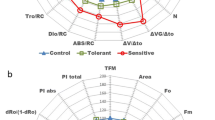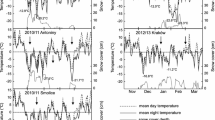Summary
Relative cold tolerances were determined for 18 genotypes of wild and cultivated potato (Solanum spp.); eleven were from high altitude and were considered to be adapted to cold environments, and the remaining seven were cultivars ofS. tuberosum of which four originated from Chile. Relative cold sensitivity of the genotypes was measured by the decrease in the rate of the induced rise in chlorophyll fluorescence in leaflets kept at 0°C in the dark. Most wild species showed a greater tolerance to the low temperature and the results show a large genotypic range within theSolanum spp. for cold tolerance at 0°C. genotypes ofS. tuberosum showed a large range in cold sensitivity. This genotypic range in cold sensitivity, the use of chlorophyll fluorescence analysis as a screening technique and the relationship betweenF R andF var are discussed.
Zusammenfassung
Für 18 Genotypen wilder und kultivierter Kartoffeln (Solanum spp.) wurden die Kältetoleranzen ermittelt. Elf der Genotypen waren Wildspezies und galten als adaptiert an kalte Umgebungen. Die restlichen sieben waren Sorten vonS. tuberosum, von denen vier aus Chile stammten. Die relative Kältesensibilität der Genotypen wurde anhand des Rückgangs des Ausmasses des induzierten Anstieg der Chlorophyll-Fluoreszenz in Blättchen bei 0°C im Dunkeln gemessen, und wurde in Form der Zeit für einen 50 %igen Rückgang derF R (maximale Rate des induzierten Anstiegs der Chlorophyll-Fluoreszenz) im Vergleich zur Kontrolle registriert. Die Mehrzahl der wilden Spezies zeigte eine höhere Toleranz für niedrige Temperatur, und die Ergebnisse zeigen eine grosse genotypische Schwankungsbreite für Kältetoleranz bei 0°C innerhalb derSolanum-Spezies.S. albicans zeigte die grösste Toleranz gegenüber Stress mit einem Kältetoleranz-Wert von 78 Stunden,S. tuberosum (CPC 3294) nur einem Wert von 24 Stunden für einen 50%igen Rückgang derF R. Eine grosse genotypische Bandbreite scheint innerhalb vonS. tuberosum zu bestehen (Tabelle 1), welche sich als sehr wichtig für die Züchtung kältetoleranterer Sorten erweisen könnte. Gegenüber europäischen Sorten zeigten die chilenischen die grössere Toleranz für niedrige Temperatur. Dennoch erwies sich die Sorte Moira kältetoleranter als andere europäische Sorten.
Die in dieser Studie verwendete Chlorophyll-Fluoreszenz-Methode ist ein Schnelltest mit Anwendung von einzelnen Blättchen, und, wie alle Kurzzeittests dieser Art, erfordert er Sorgfalt bei der Anwendung und bei der Ausdehnung der Ergebnisse auf die Pflanze als Ganzes und zum jeweiligen Wachstumsstadium über die Vegetationsperiode. Dennoch erweist sich die Möglichkeit, anhand der Chlorophyll-Fluoreszenz-Analyse sowohl inter-als auch intraspezifisch Abstufungen in der Kältetoleranz zu unterscheiden, bei wilden und kultivierten Kartoffelspezies als potentieller Anwendungsbereich für die Methode, in zukünftigen Kartoffelzüchtungs-Programmen auf Kältetoleranz zu selektieren.
Résumé
La tolérance relative au froid de 18 génotypes d'espèces sauvages et cultivées deSolanum a été déterminée. Onze étaient des espèces sauvages considérées comme adaptées à des conditions d'environnement froides et sept étaient des variétés deS. tuberosum, parmi lesquelles quatre originaires du Chili. Comparativement à des témoins non traités la relative sensibilité au froid étai évaluée par la perte d'intensité de fluorescence de la chlorophylle provenant de folioles conservées à 0°C dans l'obscurité. La majorité des espèces sauvages se montrait plus tolérante vis à vis des basses températures; dans l'ensemble les résultats mettaient en évidence une large gamme de tolérance à 0°C pour les espèces deSolanum: S. albicans était le plus tolérant au stress avec un temps de 78 heures alors queS. tuberosum (CPC 3294) y était le moins avec seulement 24 heures pour obtenir une extinction de la fluorescence de 50%. La gamme de tolérances rencontrée chezS. tuberosum (tableau 1) pourrait s'avérer très importante pour une hybridation ayant comme objectif l'obtention des variétés plus résistantes au froid. Les variétés chiliennes montraient une plus grande tolérance aux basses températures que les variétés européennes cependant, parmi ces derniéres, ‘Moira’ était plus tolérante au froid que les autres.
La méthode d'évaluation basée sur la fluorescence de la chlorphylle utilisée dans cette étude est un test rapide n'utilisant que quelques folioles et, comme pour tous les tens simples et rapides, il est nécessaire d'être prudent avant de transposer les résultats obtenus à la plante entière et à toutes les époques de la période de croissance de la plante. Cependant la capacité de cette méthode à déceiler des degrés de tolérance au froid entre espèces sauvages et entre celles-ci et les variétés cultivées suggère un usage possible pour la détection de ce caractère dans les futurs programmes d'hybridation de la pomme de terre.
Similar content being viewed by others
References
Barnes, J. D. & J. M. Wilson, 1984. Assessment of the frost sensitivity ofTrifolium species by chlorophyll fluorescence analysis.Annals of Applied Biology 105: 107–116.
Burton, W. G., 1966. The potato. Veenman and Zonen, Wageningen.
Burton, W. G., 1978. The physics and physiology of storage. In: P. M. Harris (Ed.), The potato crop, p. 545–606. Chapman and Hall, London.
Burton, W. G., 1981. Challenges for stress physiology in potato.American Potato Journal 58: 3–14.
Chen, H. H. & P. H. Li, 1980a. Characteristics of cold acclimation and de-acclimation of tuber-bearingSolanum species.Plant Physiology, 65: 1146–1148.
Chen, H. H. & P. H. Li, 1980b. Biochemical changes in tuber-bearingSolanum species in relation to frost hardiness during cold acclimation.Plant Physiology 66: 414–421.
Correll, D. S., 1962. The potato and it's wild relatives. Texas Research Foundation, Renner.
Dexter, S. T., W. E. Tottingham & L. F. Graber, 1932. Investigations of the hardiness of plants by measurement of electrical conductivity.Plant Physiology 7: 63–78.
Hawkes, J. G., 1978. Biosystematics of the potato. In: P. M. Harris (Ed.), The potato crop, p. 15–69. Chapman and Hall, London.
Hetherington, S. E. & R. M. Smillie, 1982. Tolerance ofBorya nitida, a poikilohydrous angiosperm, to heat, cold and high light-stress in the hydrated state.Planta 155: 76–81.
Hetherington, S. E., R. M. Smillie, P. Malagamba & Z. Haman, 1983. Heat tolerance and cold tolerance of cultivated potatoes measured by the chlorophyll fluorescence method.Planta 159: 119–124.
Larcher, W., 1981. Resistenzphysiologische Grundlagen der evolutiven Kälteakklimatisation von Sprosspflanzen.Plant Systematics and Evolution 137: 145–180.
Li, P. H., J. P. Palta & H. H. Chen, 1979. Freezing stress in potato. In: J. M. Lyons, D. Graham & J. K. Raison (Eds.), Low temperature stress in crop plants: The role of the membrane, p. 291–303. Academic Press, New York.
Margulies, M. M. & A. T. Jagendorf, 1960. Effect of cold storage of bean leaves on photosynthetic reactions of isolated chloroplasts.Archives of Biochemistry and Biophysics 90: 176–183.
Moorby, J. & F. L. Milnthorpe, 1975. Potato. In: L. J. Evans (Ed.), Crop physiology, p. 225–257. Cambridge University Press, Cambridge.
Ögren, H. & G. Öquist, 1985. Effects of drought on photosynthesis, chlorophyll fluorescence and photoinhibition susceptibility in intact willow leaves.Planta 166: 380–388.
Palta, J. P., J. Levitt & E. J. Stadelmann, 1977. Freezing injury in onion buld cells. I. Evaluation of the conductivity method and analysis of ion and sugar efflux from injured cells.Plant Physiology 60: 393–397.
Papageorgiou, G., 1975. Chlorophyll fluorescence: an intrinsic probe of photosynthesis. In: Govindjee (Ed.), Bioenergetics of photosynthesis, p. 320–366. Academic Press, New York.
Ralph, W., 1984. An aid to breeding more tolerant plants.Rural Research 123: 8–11.
Richardson, D. G. & C. J. Weiser, 1972. Foliage frost resistance in tuber-bearingSolanums.Horticultural Science 7: 9–21.
Rosinger, C. H., M. W. Kerr & J. M. Wilson, 1982. Changes in the temperature response of Hill reaction activity of chilling-sensitive and chilling-resistant plants after hardening.Journal of Experimental Botany 33: 321–331.
Schreiber, U., L. Grobermann & W. Vidaver, 1975. A portable, solid state fluorometer for the measurement of chlorophyll fluorescence induction in plants.Review Scientific Instruments 46: 538–542.
Simmonds, N. W., 1962. Variability in crop plants, it's use and conservation.Biological Review 37: 442–465.
Smillie, R. M., 1979. The useful chloroplast: a new approach for investigating chilling stress in plants. In: J. M. Lyons, J. Graham & J. K. Raison (Eds.), Low temperature stress in crop plants: The role of the membrane. p. 187–202. Academic Press, New York.
Smillie, R. M., & G. C. Gibbons, 1981. Heat tolerance and hardening in crop plants measured by chlorophyll fluorescence.Carlsberg Research Communication 46: 395–403.
Smillie, R. M. & S. E. Hetherington, 1983. Stress tolerance and stress-induced injury in crop plants measured by chlorophyll fluorescence in vivo.Plant Physiology 72: 1043–1050.
Smillie, R. M. & S. E. Hetherington, 1984. A screening method for chilling tolerance using chlorophyll fluorescence in vivo. In: C. Sybesma (Ed.), Advances in photosynthetic research, Vol. IV. Martinus Nijhoff/Dr W. Junk Publishers, The Hague/Boston/Lancaster.
Sukumaran, N. P. & C. J. Weiser, 1972. An excised leaflet test for evaluating potato frost tolerance.Horticultural Science 7: 467–468.
Sundbom, E. & G. Öquist, 1982. Temperature-induced changes in variable fluorescence yield A screening method for frost tolerance in potato (Solanum sp.).Plant Physiology 70: 1299–1302.
Author information
Authors and Affiliations
Rights and permissions
About this article
Cite this article
Greaves, J.A., Wilson, J.M. Assessment of the non-freezing cold sensitivity of wild and cultivated potato genotypes by chlorophyll fluorescence analysis. Potato Res 29, 509–520 (1986). https://doi.org/10.1007/BF02357915
Accepted:
Issue Date:
DOI: https://doi.org/10.1007/BF02357915




